|
Creature Feature:
The Zombie Films of George A. Romero
The zombie genre has
always had quite a bad reputation as being the ultimate splatter exploitation genre, only
surpassed in notoriety by cannibal movies. It can't be denied that most zombie features rank among the goriest in movie history. Still, it
would not be fair to condemn all these films as mindless trash with the only purpose to show explicit violence and brutality. Although such condemnations might be right with many of the Italian
1980s gore films by directors such as Lucio Fulci, the Living Dead
series of Pittsburgh director/writer George A. Romero calls for a more differentiated analysis.
Born in the Bronx in 1939, Romero made his first 8mm films while he
was still a teenager. He studied art, design, and theater at the
Carnegie-Mellon Institute of Art in Pittsburgh, and graduated in
1961. Subsequently, he formed his own company, Latent Image, to
produce industrial films and television commercials. In 1967, he
teamed up with another Pittsburgh advertising firm, Hardman
Associates, to produce a low-budget feature-length horror film.
Nobody expected that he was about to produce one of the most
influential films in the history of horror: Night of the Living Dead.
|
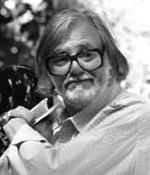
George A. Romero,
father of the walking dead |
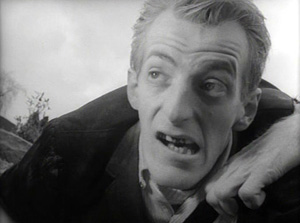
Movie history's first "real" zombie (S. William Hinzman)
is going to get her:

Barbara (Judith O'Dea), damsel in distress.

The unlikely hero: Duane Jones as Ben |
Night of
the Living Dead (1968)
In
1968, George A. Romero's debut
The Night of the Living Dead laid the foundation for his reputation as one of the most important directors of fright films. Made on a shoestring budget and using atmospheric black-and-white photography, the movie shows how the dead start to rise without any explanation and living humans
become their favorite dinner dish. Setting the tone for the remaining 90 minutes,
Night of the Living Dead begins in a cemetery, where Barbara and her brother Johnny are attacked by a strange man. While Johnny is killed by the ghoul, Barbara escapes to a nearby country house, where she meets Ben,
an Afro-American, and falls into a state of catatonia. The rest of the film is set mostly in this house and follows the small group of survivors who seek shelter from the undead. The focus, however, is not on the flesh-munching monsters outside, but on a slowly escalating conflict among the group in the house, in particular between Ben and Harry Cooper, a white family father. While Cooper and his family barricade themselves in the basement cellar without caring for anybody else in the house, Ben makes plans for an escape.
Unfortunately the attempt to flee the house in a truck fails, which is
not Ben's fault, but due to an unfortunate series of events. At the
end of the film Ben remains the only survivor, all the others have
fallen victim to the living dead due to their own or Cooper's fault.
Night of the Living Dead begins without any explanation. The dead just keep coming back from their graves and no one seems to know why - only a goofy
theory is given by a scientist on TV, who blames the zombie plague on radiation from a space satellite probe. The film also does not provide a
resolution for the zombie plague. The bleak ending, perfectly in tune with the
over-all dark atmosphere of the film, sees the only survivor, Ben, shot by a band of militia members, while the
battle of humans against the ghouls seems to continue. But as said before, the real center is the conflict
among humans, the outside threat of the man-eating zombies is only a backdrop for a psychological study of people in an extreme situation.
Still, many of its unique aspects - the black-and-white photography, the single location, the gritty documentary-style look - can be attributed to the restricted budget of only $ 114,000, which did not leave much room for great scale and expensive shoots.
At the time of its release Night of the Living Dead shocked its audience with extreme depictions of violence. People were shot in the
head on screen, and the cannibalistic zombies were shown devouring
pieces of human flesh. Of course by today's standards these images might seem tame, but in 1968 they were as far as Romero could go.
Night of the Living Dead inspired countless imitations and set the standards for most zombie movies released in subsequent years. It is no coincidence that the New York Museum of Modern Arts deemed it as worthy being protected and included the movie in its collection.
|
|
Dawn
of the Dead (1978)
Ten years after Night of the Living Dead George Romero returned with a sequel to his classic, this time in full colour and with financial
backing by Italian horrormeister Dario Argento.
Dawn of the Dead (1978) sees the armies of the undead spreading all over the USA,
while a national state of emergency has been announced. Four survivors, a soldier, a pilot, his girlfriend and an Afro-American
man escape in a helicopter and take refuge in an abandoned shopping mall,
that is solely populated by living dead. Initially
everything goes as planned: the quartet manages to clear out the zombies from the mall, and they hole up inside, where they have enough supplies and food to survive a long time. However, this idyll is destroyed when a marauding band of motorcyclists break into the mall. This also makes it possible for the zombies to return to the mall and a gruesome fight on several fronts breaks out: it's humans against humans and zombies against humans. In the end the sole survivors of the massacre are Stephen, the
Afro-American and Francine, who board the helicopter to escape into an uncertain future.
|
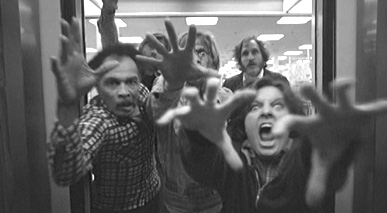
When there is no more room in hell the dead will walk the earth... |
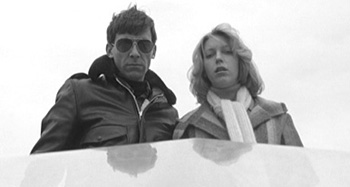
Stephen (Scott Reiniger) and Francine (Gaylen Ross) |
Just like Night of the Living Dead, Dawn of the Dead focuses not on the fight against the zombies - although Romero shows
also in great detail how the refugees dispatch of zombies - but on the relationships and conflicts among the group of survivors. Four completely different characters have to get along with each other, deal with problems, overcome reservations and work together in an extreme situation, where law and order do not exist any more. It is also characteristic of Romero's zombie movies that the ultimate catastrophe is not caused by growing outside forces (the zombies could have been kept at bay easily) but
initiated by the stupidity of other humans, in this case the motorcyclists who break into the mall and thereby open the floodgates for the undead hordes to prey on the small group of survivors.
|
Another
parallel between Night of the Living Dead and Dawn of the Dead
is that once again the movie does not try to give any scientific explanation of the source of the epidemic.
The only attempt of explaining the sudden arrival of the undead is made
by Peter: Citing religious superstition, he refers to his grandfather, a
voodoo priest in Trinidad, who used to say, "When there is no more room
in hell the dead will walk the earth."
Just as the viewers are thrown into a world of chaos from minute one, they are left after 120 minutes without a satisfying conclusion and without any assurance that the two survivors might live long enough to see the end - if there ever is an end to the zombie epidemic.
Dawn of the Dead is a small episode in a world-wide catastrophe, an exploration of conflict in a societal microcosm, rather than a global analysis of the final apocalypse.
|

Blowing off heads has put a smile on his face: Peter (Ken Foree) |

Roger (Scott Reiniger) dispatching an undead with a certain sense of joy |
Dawn of the Dead is also frequently interpreted as a satire on consumerism, although Romero never explicitly intended it to be a social comment.
When Fran asks Steven, why the zombies come to the mall, he answers, "Some
kind of instinct. Memory of what they used to do. This was an important
place in their lives." And indeed, the mindless zombies populating the deserted mall on first view don't
behave and look a lot different from the usual masses of shoppers, when they stroll and
aimlessly wander around in the mall, complete with
easy listening elevator music and queues on escalators. Even after
their death the zombies keep coming back to the shops driven on some
kind of instinct to consume, although the shops and the goods on offer
are of no use to them anymore. Of course, this poses the question if
they ever were, if they really needed all those things they bought when
they were still alive.
|
| Additionally, when the group of refugees hole up in the mall, they revel in absolute consumer excess, only without having to pay (or as if using credit cards).
It is almost like a consumer's dream come true. Basically, they all go on a prolonged shopping spree, taking whatever they want and need from the stores. The mall becomes their own private shopping paradise and the zombies become toys, a means of entertainment when Ben and the others go on a safari-style hunt for zombies. Therefore the invasion of the biker gang might serve as a metaphor for the theory that excessive consumerism might eventually come to a catastrophic end, brought upon by humans themselves, in a system that can't continue to work, because
either the envious neighbor or the poor masses will finally overthrow the system and bring chaos and destruction. Society will eat itself, when those who have been oppressed for far too long stand up.
|
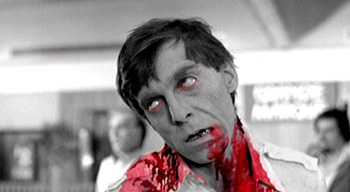
Stephen returns from the dead |
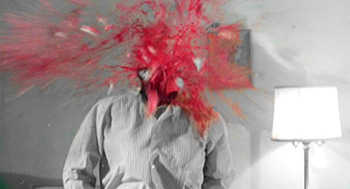
Finally a horror movie with brains:
The notorious exploding head shot was cut
from most versions of Dawn of the Dead. |
Just as Night of the Living Dead raised the level of on-screen violence,
Dawn of the Dead once again pushed the boundaries of what could be shown in a movie. Romero was now able to show all the gory details and gave them unusually much room. In
Dawn of the Dead heads are blown off, humans are disemboweled and torn into pieces, screwdrivers are driven into heads and limbs are chopped off. Consequently,
this kind of overly explicit carnage earned the film an X-rating and it fell victim to national censorship in many countries.
In addition to censored versions, the movie exists in (at least) two different cuts, mainly due to the involvement of Italian producer Dario
Argento, whose contract gave him the right to edit his own version for the European market. Being about 20 minutes shorter than Romero's edit, the
"Argento cut" leaves out several scenes of dialogue, character development and some of the comedy elements, resulting in a more fast-paced, grim version, lacking the depth of Romero's original cut. |
|
Day
of the Dead (1985)
In Day of the Dead (1985), the third chapter of Romero's Dead
series, the undead have finally overrun mankind. Hidden in a subterranean missile vault, a group of survivors are desperately trying to get the situation under control. On the one hand a band of soldiers keep blowing off zombie heads, while a group of scientists try to find the reasons behind the epidemic that brings the dead back to life. Chief scientist "Frankenstein" Logan's only success is
Bub, a "domesticated" zombie, who likes reading and listening to classical music before feasting on human flesh served to him in a bucket. Already high on tension, the conflict between the two groups escalates, when Rhodes, the increasingly psychotic leader of the military group, finds out that Logan conducts experiments with deceased soldiers. The scientists are massacred by the soldiers, who in turn fall prey to the zombies, that finally manage to break into the military compound. The end of the movie sees three survivors: Sarah, the only woman left, John, the only Afro-American in the group, and Bill, an alcoholic pilot, all of them sorts of outsiders among these last remains of humankind. They manage to flee to a remote island by helicopter, where they finally can enjoy peace and quiet on a sunny beach.
|

Day of the Dead's "good guys": John (Terry Alexander),
William (Jarlath Conroy) and Sarah (Lori Cardille) |
This continues Romero's tradition of making
Afro-Americans the true winners and superior characters in his films. In Night
of the Living Dead it is Ben (although he is ironically shot by
supposedly racist redneck militia members), in Dawn of the Dead Peter
survives all the massacres, and in Day of the Dead we see once again
an Afro-American who behaves more sensibly than most whites and therefore
manages to stay alive.
In Dawn and Day Romero also presents women as strong and smart
characters. While in Night of the Living Dead Barbara was the weak,
almost catatonic damsel in distress, dependent on an active man (at that
time the traditional role for women in horror movies), the sequels depict
increasingly strong, emancipated women. Dawn of the Dead's Francine
learns to shoot and defend herself in the course of the movie. Day of the
Dead's Sarah already starts out as a gun-toting, independent woman, who
strongly opposes the military group's leader Rhodes and never hesitates when
it comes to killing off zombies.

Dr. Logan "Frankenstein" (Richard Liberty) prepares for
surgery. |
Even bleaker in atmosphere than Dawn of the Dead, Day of the Dead leaves the last remnants of mankind with absolutely no trace of hope - there are no more TV broadcast, all nearby cities are deserted (except for the zombies) and there is no more contact to anyone alive outside the bunker. In the end Sarah, John and Bill might well be the last humans alive on the planet, but at least they have hope of a bright future on the sunny island, where they might start a new life and prosper.
|
Once again Romero focuses on the conflicts between humans in an extreme situation. The hordes of the undead become less important, the true threat in this film are psychotic military members and mad scientists.
Because Romero refused to deliver an R-rated film, he had to do with a very limited budget of only $3.5m. The original screenplay had intended a much bigger scale, but would also have required a much bigger budget. Due to the budget limitations, Romero cut his screenplay and turned the movie into a dialogue-laden chamber play, almost solely set in the claustrophobic setting of the underground missile bunker. Social commentary is almost entirely dropped in favor of endless arguments and cursing among the soldiers and scientists.
|
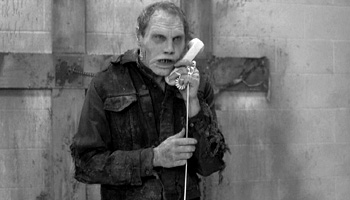
Zombie phone home - Bub (Sherman Howard), the talking zombie |
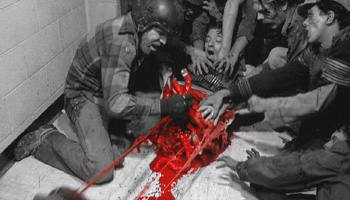
Capt. Rhodes (Joseph Pilato) is getting served for breakfast |
Some genre fans and critics were disappointed by the movie's small scale approach and tiresome dialogue. However, they were compensated with some of the most gruesome gore effects ever created. Once again Romero and FX wizard Tom Savini managed to increase the carnage and delivered a bloodfeast that truly deserved its X-rating.
Sadly, Day of the Dead has commonly been ignored by critics or often dismissed as far inferior compared to its two predecessors. Some of the points of criticism, mainly the overacting of Cardille and
Pilato, but also the weak, truncated script and the lack of depth and character development might be justified. It still remains a quality horror movie, which only has the disadvantage of being the third in a series of acknowledged classics.
|
|
Land
of the Dead (2005)
20 years after Day of the Dead George Romero finally delivered the long-awaited fourth
instalment in his zombie series: Land of the Dead (2005),
financed by major
Hollywood studio Universal. Originally entitled Dead Reckoning, the movie is
set in a city populated by a two-class society: while a few, who can afford
it, populate the luxury high-rise tower "Fiddler's Green", the majority of
the people dwell in run-down buildings and slums surrounding the tower while
the zombies are kept out by heavily guarded fences and gates. The town is
governed by Kaufman (Dennis Hopper), who makes sure that only those with
enough money make it into "Fiddler's Green".
At the focus of the film are Riley
(Simon Baker) and Cholo (John Leguizamo), who cruise the zombie-infested
city in search for supplies and food in an armoured vehicle called "Dead
Reckoning". Cholo, who secretly works for Kaufmann, dreams of buying himself
a way into "Fiddler's Green", but is denied a place among the rich and
beautiful by Kaufman. |
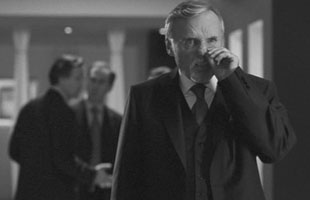
Angry nose-picker: Dennis Hopper as Kaufman |
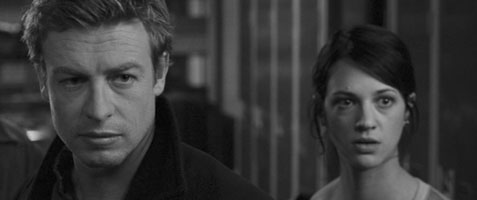
Angry zombie slayers: Riley (Simon Baker) and Slack (Asia Argento)
|
Meanwhile one of the zombies has
developed traces of intelligence and leads the undead into the center of the
city. Finally, they overrun "Fiddler's Green", killing everyone inside
including the corrupt Kaufman. While Cholo is bitten and turns into a living
dead, Riley hi-jacks "Dead Reckoning" and sets off to Canada, where he and
his crew hope to find a zombie-free world.
|
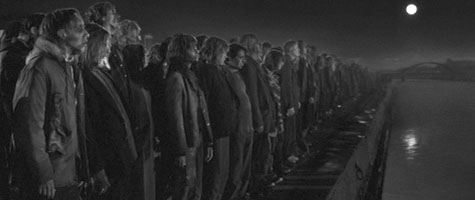
Angry zombies: The living dead prepare to coss the river |
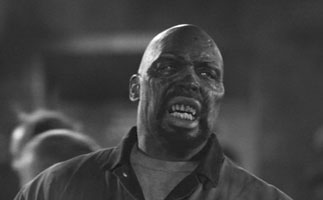
Angry African American: Big Daddy (Eugene Clark) leads the zombies |
In Romero's fourth living dead
feature, the development begun in 1968 sees its logical continuation. The
zombies become more human and manage to get organized in their ongoing
search for food. Their leader "Big Daddy" turns out like Day of the Dead's
Bub, only on a further developed level, since his intelligence was not the
result of guinea pig training in a scientific laboratory. He also continues
Romero's portrayal of Afro-American heroes, only this time the zombies are
clearly presented as the oppressed part of society, who need to rise to
regain their rights. |
|
On the other hand humans are
portrayed as increasingly losing their humanity. Where Night of the
Living Dead presented the rampaging lynch mob, Dawn of the Dead a
band of marauding bikers and Day of the Dead a repulsive band of army
soldiers, in Land of the Dead there is Kaufman, who
ruthlessly exploits the poor underclass outside of Fiddler's Green and rules
the town like an absolutist monarch. Even more importantly, many of the humans outside celebrate a
continuing downfall of civilisation, where zombies (and incidentally humans
as well) are slaughtered for fun and greed and backstabbing dominate
every-day life.
|
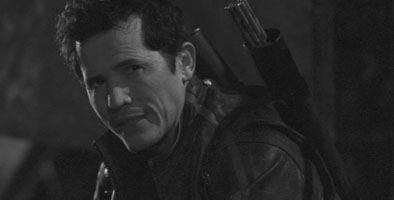
Angry Latin American: Cholo (John Leguizamo) before joining the
living dead |
This time the political subtext is not as obvious as in Dawn of the Dead,
but Romero still manages to provide a genre film that works as a commentary
on the current state of our society. Today's world is dominated by a few
governments and multi-national corporations, while developing countries are
denied their share of the world's wealth, which they help to produce but
cannot enjoy, just like the zombies and starving masses in front of the
doors to "Fiddler's Green".
It was quite a surprise that despite the backing of a major
Hollywood studio, George Romero delivered his trade-mark excess gore,
including the usual gut munching and plenty of brutal headshots. This move
is rather surprising, considering that for the first time Romero was able to
work with a large budget and A-list Hollywood actors, among them Dennis
Hopper and Asia Argento, daughter of fellow horror-meister Dario Argento.
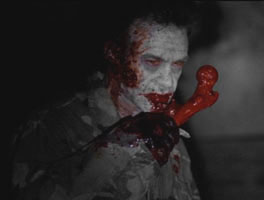

Angry bone-muncher: Romero still delivers the gory goods
Angry face-lift: female zombie
Diary
of the Dead (2007)
Quicker than expected George
Romero delivered his fifth Living Dead movie in 2007, entitled Diary of the
Dead. Disappointed from working with a major studio on Land of the Dead,
Romero returned to his independent roots and made his latest zombie movie
with his own production company on a shoestring budget of around $ 2m.
Diary of the Dead marks a new stylistic approach for zombie movies and also
a new one for Romero. The movie poses as a fake documentary, chronicling the
journey of a group of film students who try to cope with an ongoing zombie
epidemic while trying to find a safe place to hide.

Shooting the undead with lenses and bullets
Unlike other such movies, most notably The Blair Witch Project and
Cloverfield,
Diary of the Dead not only uses material recorded by the students with
hand-held cameras. It claims to be edited together from several sources,
including security camera footage, TV news clips and films downloaded from
the internet. The movie opens with footage of a
camera crew – later it is revealed that it was downloaded from the internet
– who document the first zombie incident, when dead bodies at an urban crime
scene come back to life and attack police and the TV crew.

Pissed off and hungry for flesh |
Next we see some film students trying to make a mummy horror movie. This endeavor is suddenly interrupted when they get the news of the zombie
epidemic on TV and embark on their journey to one of the girls’ parents’
home. Jason, the director, decides to record this event and to turn it into a
documentary entitled "The Death of Death", because “if it is not on film it
never happened”.
On their journey the students, accompanied by their booze-loving professor,
run into various people: a group of African Americans who round up in a
warehouse (like the characters in Dawn of the Dead), marauding
militia members, a mute, dynamite-toting Amish man and a deserted
hospital, inhabited solely by living dead. |
While the students are slowly being killed
off on this trip, the last survivors are Debra and the elderly professor.
They lock themselves in a panic room at a friend’s house and Debra vows to
finish Jason’s documentary.
"I see
something shitty happening in the world, and I slap some zombies on it."
According to this motto which Romero
revealed to the Rolling Stone magazine, the 68-year-old director this time
creates a satire on the post-9/11 world of internet blogs and youtube
videos, where everyone feels compelled to record everything on camera. Today
there is always someone to stick a camera right into your face, just like
Jason in Diary of the Dead. In the beginning Jason’s
documentary is more like an annoyance to the others, when he
interviews them in situations where they would rather be left alone.
Later this annoyance changes to an extent, that Jason no longer
actively intervenes to help his friends, but just stands by filming
his friends in perilous situations. |
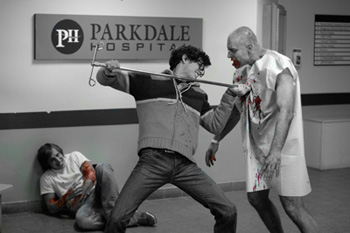
|
In a humorous twist at
the movie’s climax a zombified actor chases an actress through the woods,
tearing apart her dress while Jason films everything. The humour is created
because exactly the same set-up was discussed by the very same actors at the
beginning of Diary, when they argued about the way a dead mummy walks and
why girls in horror films always have to scream and get their dresses ripped
off.
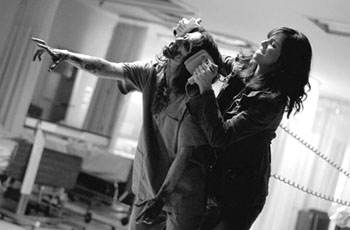
How not to use a defibrillator |
Another point Romero discusses in Diary of the Dead
is the fact that the
media create their own reality, when an edited TV broadcast about the outbreak of
the zombie invasion is considerably different from footage available on the
internet. Rather than being a non-stop gore fest, Diary of the Dead is
definitely more about how reality is perceived, how it changes on film and
how people are fooled by the premise that everything that is on film must be
true. Like with most internet bloggers, Jason’s driving force is his believe
that the media are full of lies and he has to deliver the truth. His
documentary is supposed to be an objective account of what happened and for
that purpose he has to stand by and watch and must not interfere. What he
does not comprehend is that he only shows things how he perceived them, that
by editing his documentary he changes the point of view and therefore also
distorts reality. |
Diary of the Dead also
satirizes the internet’s potential to create stars.
When Debra tries to convince Jason to abandon his documentary, he boasts on
how important the film is and that just in the last 8 minutes 72,000,000 people
watched his footage on his internet site. Convinced that he has to continue
and record everything, Jason ultimately pays with his own life when he refuses
to lock himself in the panic room with the others.
Diary of the Dead shows once again
that Romero has not lost his touch. His typical mixture of gross-out gore,
social satire and witty dialogue make this movie a unique experience.
Despite numerous inventive moments of blood-shedding (among them one
zombie’s head impaled on a scythe and another zombie’s head slowly
dissolving in acid), gore hounds will find Diary of the Dead a bit slow and
dialogue-heavy. But Romero’s zombie films have always been like that, a fact
that has made them attractive to film scholars and horror buffs alike. |
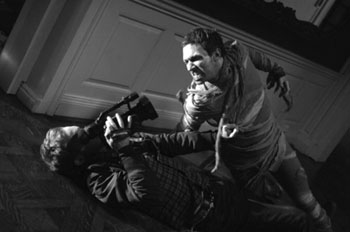
The final shot |
The bleak ending is also typical for Romero. Although three characters survive
the onscreen massacre, we are left in the dark about their fate. We only
learn that they lock themselves in the panic room and that they manage to
finish the documentary and probably upload it onto the internet. Typically for
Romero, they are outsiders: Andrew, the constantly drunk professor, who
is much older than his students; and Sarah, the only strong woman in the
group, who is also the only one to stand up against Jason and to criticize
his behavior while shooting the documentary.
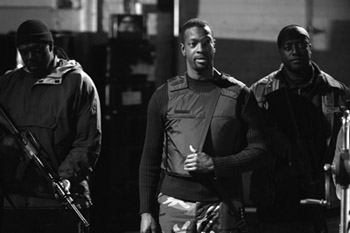 |
As usual in Romero’s Dead series, he also presents us an African American
hero. This time we even get a group of Black Panther-like Blacks, armed and
sufficiently equipped for the crisis. They boast that they are the last ones
left in their town and that for the first time they "have the power" and
decide who they share their supplies with. So Romero’s Dead films are also a
metaphor on the continuous rise of Blacks in American society. While Night
of the Living Dead’s black hero fell victim to a lynching mob, 40 years later we
see a group of African Americans, who are finally in power.
On the contrary Romero presents us a wide range of unappealing white, male
characters: most of the good-looking male members of the film students group
behave either irrationally or recklessly, in particular Jason; the uniformed
militia members take advantage of their superior fire power and rob the
students instead of aiding them; the spoilt kid Ridley, reveling in his
parents luxury, jeopardizes his friends when he hides his bite wound from
them. So once again Romero clearly points out to the audience where his
sympathy lies: it is not with the white majority, that holds the power in
the USA, but with minorities, outsiders and women who stand up for their rights. This point is underlined by the
final scene, supposedly a youtube video showing a bunch of male rednecks
using zombies and a tied woman as shooting practice targets. The movie ends
with Debra asking the audience if we are actually worth saving. |
Unofficial Sequels and Remakes
Because Romero and the producers had
lost the
copyright to Night of the Living Dead (some say it was just due to a legal
mistake that the film is now in the public domain) and therefore did not make any money from the movie, in 1990 Romero
wrote and produced a remake of his own classic, which was directed by
special effects mastermind Tom Savini. Surprisingly, the film turned out
much better than expected, thanks to good acting, superb special FX and a
much bigger budget. Romero changed a couple of things from the original
screenplay, in particular the character of Barbara. She replaces Ben as the
center of the film and is now a gun-toting, self-determined heroine.
Otherwise the 1990 version is very similar to the original, only this time
it was made in color.
In 2004 finally a remake of Dawn of the Dead was released, but this time
without the involvement of George Romero. Directed by music video director Zack
Snyder, it once again tells the story of a group of survivors hiding in a
mall, while the rest of the world seems to be run over by the living dead.
This remake loses all the social criticism of the original, instead it opts for slick MTV visuals and introduces zombies that can actually run.
The same applies to Steve Miner's direct-to-video remake of Day of the
Dead (2008), which has nothing in common with the original except the
title.
More zombie mayhem can be found in Return of the Living Dead, a horror comedy directed by Dan O'Bannon. It claims to tell the true story behind
Night of the Living Dead: dead bodies were turned into flesh-eating ghouls
by a marijuana-based nerve gas developed by the US army. While this first
film was pretty funny, its sequel
Return of the Living Dead Part 2 is for the most part unwatchable. Several years later
Brian Yuzna directed a third part, which dropped all the comedy elements and
turned out to be an actually very enjoyable, dark splatter movie.
Next Creature Feature:
Don Coscarelli's PHANTASM series !
© 2004-2008 Andreas Rohrmoser
|


